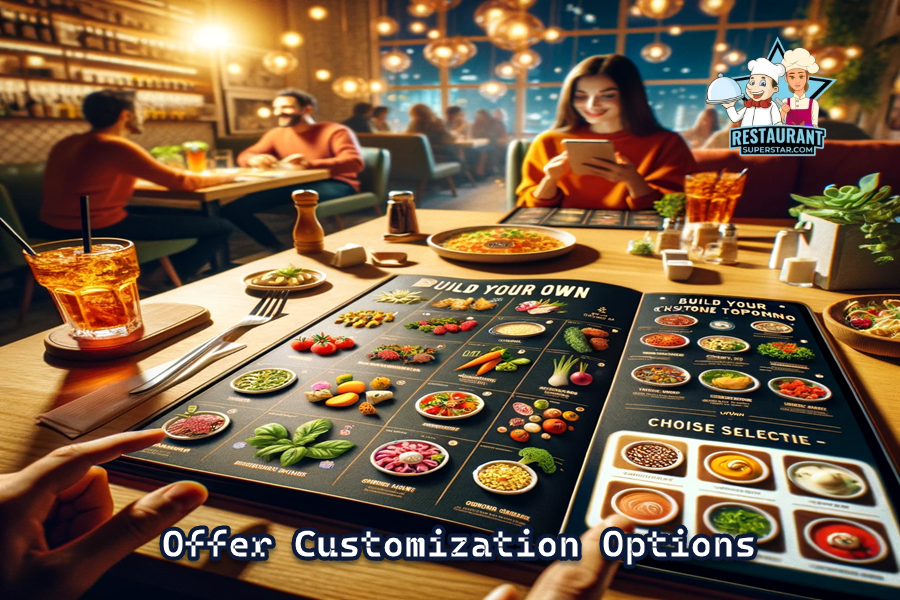How to Improve Your Restaurant Menu with Choices and Add-ons
Welcome to the ultimate guide to enhancing your restaurant’s appeal through smart menu design! If you’re wondering how to revitalize your offerings with enticing choices and add-ons, you’ve landed in the perfect spot.
This article isn’t just a treasure trove of actionable advice; it’s a roadmap to transforming your menu into a dynamic, customer-pleasing masterpiece.
We’re diving deep into the essentials of menu optimization, ensuring you grasp every opportunity to delight your patrons and boost your bottom line.
Stay tuned as we unfold secrets that will set your culinary establishment apart.
How to Improve Your Restaurant Menu with Choices and Add-ons
How to Improve Your Restaurant Menu with Choices and Add-ons? Elevating your restaurant menu involves integrating customizable options and strategic add-ons, allowing diners to tailor their meals to their liking. From offering a variety of base dishes that can be personalized with an array of toppings, sauces, and sides to introducing different portion sizes to cater to all appetites, the key lies in providing flexibility and variety.
Make sure to highlight these options on your menu, using vivid descriptions and images to entice and inform your customers.
Now, you’ve got a glimpse into revolutionizing your menu, but that’s just the tip of the iceberg.
This article will guide you through every step, ensuring you know precisely how to apply these strategies to captivate your audience.
With insights on balancing your menu, incorporating seasonal ingredients, and making the most of online ordering systems, we guarantee you’ll find invaluable tips to skyrocket your restaurant’s success.
Step 1: Empower Your Customers
Offer Customization Options

In the vibrant world of dining, giving your customers the power to build their meals is like handing them the paintbrush to color their culinary canvas.
It’s not just about eating; it’s about creating an experience that resonates personally with each diner. This revolutionary approach transforms a simple meal into an engaging, memorable event.
Why Letting Customers Build Their Own Meals Matters
Personal Touch: When diners can mix and match, they’re crafting a meal that perfectly aligns with their taste buds, dietary needs, and mood. It’s the ultimate dining delight, ensuring they leave with satisfied smiles and plans to return.
Inclusive Dining: Offering various customization options means welcoming everyone to the table, from the pickiest eaters to those with dietary restrictions. It’s about saying, “We’ve got something special for you,” no matter their preferences.
The Spectrum of Customization Options
Imagine a menu that offers a playground of choices:
Base Dishes: Start with the foundation—pizzas, salads, or bowls. These are your canvases, ready to be adorned.
Toppings Galore: From sun-ripened tomatoes to exotic cheeses, toppings are the jewels that add sparkle and personality to each dish.
Sauces with a Twist: Whether a tangy barbecue or a creamy alfredo, sauces can transform the base into a masterpiece.
Proteins for Power: Offering a range of proteins, from grilled chicken to tofu, it caters to carnivores and vegetarians alike, ensuring no one’s left out.
Sides to Complement: Sides are the perfect accompaniments, completing the meal with a harmonious balance.
Crafting the Perfect Customizable Menu
Creating a menu that offers this level of customization might seem daunting, but it’s all about striking the right balance. Consider the logistics of your kitchen, your target audience’s preferences, and your brand’s uniqueness.
The goal is to offer enough variety to excite and entice without overwhelming your kitchen or customers.
By empowering your customers to become co-creators of their meals, you’re not just serving food but providing an experience uniquely theirs.
It’s a powerful way to connect, making each visit to your restaurant a personal journey of culinary exploration.
Step 2: Entice with Add-Ons
Diving into the world of menu add-ons is like discovering a treasure trove that can significantly amplify your restaurant’s appeal and profitability. The right add-ons complement your main dishes and provide an avenue for creative expression and enhanced customer satisfaction. Let’s explore how to make these add-ons work for you and your customers.
Choose Strategic Add-Ons
The Importance of High-Profit Margin Items: Selecting add-ons with a high-profit margin is crucial. These items should enhance the main dish while being cost-effective for you to offer. Think of add-ons as the cherry on top of the cake—they should make the dish more enticing without costing you an arm and a leg.
Suggestions for Premium Toppings, Sauces, Dips, or Sides: Premium toppings could include gourmet cheeses, truffle oil, or artisanal bacon bits. For sauces and dips, consider house-made specialties or ethnic condiments with unique flavor profiles.
Sides could range from a simple salad with a signature dressing to gourmet mac and cheese. The key is offering items that customers perceive as valuable meal enhancements.
Price Add-Ons Competitively
Pricing Strategies: Your add-on pricing should balance attractiveness to customers and profitability. A good strategy is to mark up high-margin items enough to make a profit but not so much that customers are deterred. Consider offering bundles or combos with higher perceived value, encouraging customers to spend a little extra.
Upsell Strategically
The Role of Staff: Your team plays a vital role in upselling. Training your staff to understand the menu thoroughly, including the benefits and appeal of add-ons, enables them to make suggestions naturally and effectively. The key is to suggest add-ons to enhance the customer’s meal, making the suggestion feel like a helpful tip rather than a sales pitch.
Group Add-Ons Logically
Categorizing Add-Ons: Organize your add-ons in a way that makes sense to the customer. Group them by type (e.g., savory vs. sweet, hot vs. cold) or compatibility with the main dish. This logical grouping helps customers navigate their options more efficiently, reducing decision fatigue and enhancing their dining experience.
Implementing Add-On Strategies
1. Menu Design: Integrate add-ons into your menu design to highlight their appeal. Use enticing descriptions and photos or icons to draw attention to them.
2. Training: Equip your staff with the knowledge and skills to suggest add-ons effectively. Role-playing scenarios can be a fun and engaging way to prepare them for real-life customer interactions.
3. Feedback and Adjustment: Listen to customer feedback regarding add-ons and be ready to adjust your offerings based on their preferences. This could mean rotating add-ons seasonally or introducing new items to keep the menu fresh and exciting.
By carefully selecting, pricing, and promoting your add-ons, you can create a more engaging and profitable dining experience. Add-ons are not just extras; they’re an integral part of the meal that adds value for both the customer and your business.
Keep these strategies in mind as you refine your menu, and watch your customers delight in the opportunity to customize their meals in delicious and profitable ways.
Step 3: Maintain Menu Balance
In the culinary world, balance is a principle for flavors and menu design. The allure of customization and add-ons can tempt us to offer endless choices.
However, a menu that is too extensive can overwhelm customers, leading to decision fatigue and a less satisfying dining experience.
Here’s how to strike that perfect balance, ensuring your menu is enticing and manageable.
The Importance of Not Overwhelming Customers with Choices
Choice Overload: A phenomenon where too many options make decisions difficult. In a dining context, this can cause customers to feel overwhelmed, possibly resulting in dissatisfaction or even deterring them from choosing altogether.
Simplified Decision Making: A well-balanced menu guides customers to their ideal meal without making it feel like a chore. It’s about creating an enjoyable journey from curiosity to satisfaction.
Strategies for Creating a Concise Menu with Curated Add-Ons
1. Analyze and Adapt: Analyze your sales data to identify which dishes and add-ons are most popular and profitable. This data-driven approach helps decide which items to keep, tweak, or remove.
2. Curate with Care: Select a core lineup of dishes representing your brand and catering to various tastes. Then, carefully choose add-ons that complement these dishes, adding variety and customization opportunities without cluttering the menu.
3. Categorize Creatively: Organize your menu to make navigation intuitive. Group dishes and add-ons by type or theme, and consider using visual cues or icons to denote customizable options.
4. Seasonal and Special Menus: Leverage seasonal ingredients and special occasions to offer limited-time dishes and add-ons. This helps keep the menu fresh and allows for a controlled introduction of new choices without permanent complexity.
5. Feedback Loop: Regularly solicit and review customer feedback about the menu. This will help you understand their preferences and how they navigate your menu choices, allowing continuous refinement.
6. Train Your Staff: Ensure your staff is well-versed in the menu’s structure and can efficiently guide customers through their choices. Staff recommendations help simplify the decision-making process for customers.
7. Visual Simplicity: Design your menu to be visually appealing and easy to read. Avoid clutter and use clear, concise language to describe dishes and add-ons. High-quality images should be used sparingly and strategically to highlight signature or customizable dishes.
Implementing Menu Balance
Achieving a balanced menu is an ongoing process of refinement and adaptation. It requires a profound understanding of your customers’ preferences, operational capabilities, and brand identity.
By focusing on a curated selection of dishes and add-ons, you can enhance the dining experience, making it memorable and enjoyable.
This approach helps manage kitchen complexity, reduce waste, and strengthen your brand’s appeal by offering a focused, cohesive dining experience.
A well-balanced menu serves as a foundation for a successful restaurant, enticing customers with the right amount of choice and customization. It’s about offering various options that inspire and delight without being overwhelming.
Remember these principles as you design and refine your menu, and you’ll create an experience that customers will cherish and return to.
Step 4: Highlight Seasonal Offerings
Incorporating seasonal offerings into your menu is like giving your dishes a timely refresh button that aligns with the rhythm of nature. It’s a celebration of peak freshness, sustainability, and the art of culinary creativity.
By weaving fresh, seasonal ingredients into your choices and add-ons, you create a dynamic menu that tastes better and tells a story about quality and mindfulness.
Let’s explore the myriad benefits of this approach.
Freshness on the Plate
Peak Flavor and Nutrition: Seasonal ingredients are harvested at the height of their freshness, which means they pack a punch in terms of flavor and nutritional value. Dishes made with these ingredients are naturally more vibrant and delicious, offering a culinary experience that out-of-season produce can’t match.
Visual Appeal: Seasonal produce often looks as good as it tastes. Bright, vibrant colors from fresh fruits and vegetables can make your dishes Instagram-worthy, attracting your customers’ eyes and palates.
Sustainability and Support for Local Communities
Reduced Environmental Impact: Seasonal ingredients typically require less transportation and storage, reducing their carbon footprint. By featuring these ingredients, your restaurant contributes to more sustainable food practices.
Boosting Local Economy: Sourcing ingredients from local farmers and producers supports the local economy and builds community. It’s a narrative that resonates with many diners today, who appreciate knowing that their meal choices help sustain local agriculture and businesses.
Menu Diversity and Innovation
Inspiration for Creativity: The changing seasons offer a natural cycle of variety that can inspire your menu offerings. This encourages culinary innovation, keeping your dishes fresh and exciting for your chefs and customers.
Dynamic Menu: A menu that changes with the seasons keeps customers returning to see what’s new. It creates anticipation and excitement around dining out, making each visit a unique experience.
Marketing and Customer Engagement
Storytelling Opportunities: Seasonal ingredients come with their own stories—where they’re grown, how they’re harvested, and why they’re special. Sharing these stories can enrich the dining experience, making it more engaging and memorable for your customers.
Promotional Potential: Seasonal specials and limited-time offers can be powerful marketing tools. They provide content for social media, newsletters, and other marketing channels, helping to draw in diners looking for something new and timely.
Implementing Seasonal Offerings
1. Collaborate with Suppliers: Build relationships with local farmers and suppliers to understand what will be available each season. This can help you plan your menu and secure the best ingredients.
2. Educate Your Staff: Ensure your staff knows the seasonal ingredients featured on your menu. They should be able to share stories about the ingredients and recommend dishes to customers.
3. Highlight Seasonal Items on Your Menu: Use design elements like icons, borders, or special sections to make seasonal offerings stand out. This draws attention to these items and encourages customers to try them.
4. Feedback Loop: Gather customer feedback on your seasonal dishes. This can provide valuable insights into preferences and trends, helping you refine future offerings.
By emphasizing seasonal ingredients in your choices and add-ons, you enhance the dining experience with fresh flavors and align your restaurant with values of sustainability and community support. It’s a strategy that benefits your business, customers, and the planet.
Step 5: Consider Visual Presentation
The adage “we eat with our eyes first” holds profound truth in the culinary world. The visual presentation of your menu plays a pivotal role in captivating customer interest, shaping their dining choices, and ultimately influencing their satisfaction and memory of the experience.
Investing in high-quality photos and crafting enticing descriptions should be a cornerstone of your menu design strategy.
The Power of High-Quality Photos
Sparking Appetite: A stunning photograph of a dish can almost instantly evoke cravings and encourage customers to order. High-resolution, well-lit photos that highlight the textures and colors of your dishes can transform mere interest into a decision.
Setting Expectations: Photos provide a visual benchmark for customers, giving them a clear idea of what to expect. This alignment of expectation and reality is crucial for customer satisfaction. It can significantly reduce the chances of dissatisfaction or complaints.
Enhancing Perceived Value: Professionally taken photos showcase your food in the best light and elevate the perceived value of your dishes. Customers are often willing to pay more for a dish that looks delicious and well-presented in photos.
Crafting Enticing Descriptions
Creating a Sensory Experience: Well-written descriptions go beyond the ingredients to evoke the senses. They tell a story of taste, texture, and aroma, inviting diners to imagine the experience of enjoying the dish.
For example, describing a dish as “succulent, slow-roasted pork belly with a crispy, caramelized crust, served over a bed of creamy, garlic-infused mashed potatoes” can stimulate the imagination and appetite.
Highlighting Unique Selling Points: Use descriptions to spotlight what makes a dish special, such as locally sourced ingredients, unique flavor combinations, or traditional cooking methods. This can help differentiate your offerings from competitors and cater to trends like farm-to-table dining.
Building Anticipation and Excitement: Enticing descriptions can create anticipation for the meal. They set the stage for the dining experience, making ordering a part of the adventure.
Best Practices for Visual Presentation
1. Professional Photography: Invest in a professional photographer specializing in food. The proper lighting, angles, and styling can make all the difference in how your dishes are perceived.
2. Menu Layout: Balance photos and descriptions in your menu layout to avoid clutter. Consider featuring photos for signature dishes or using them sparingly as highlights to maintain an elegant and readable menu design.
3. Keep it Real: Ensure that your photos accurately represent the dishes you serve. Over-promising and under-delivering can lead to disappointment and damage your reputation.
4. Update Regularly: As you update your menu or seasonal offerings, update your photos and descriptions to match. This keeps your menu fresh and aligned with your current offerings.
5. Train Your Staff: Equip your staff with the stories behind the dishes. Their ability to verbalize what makes a dish special can complement the visual and written presentation on the menu.
Incorporating high-quality visuals and enticing descriptions into your menu isn’t just about aesthetics; it’s a strategic tool for enhancing customer engagement, satisfaction, and your restaurant’s success. Investing in these elements creates a more immersive and compelling dining experience that begins when a customer picks up the menu.
Step 6: Test and Iterate
In the dynamic landscape of the culinary world, staying static is not an option. The secret sauce to keeping your menu vibrant and relevant lies in experimentation.
Testing different combinations, tweaking price points, and actively seeking customer feedback are crucial practices that ensure your menu remains a living, breathing entity that evolves with your customers’ tastes and preferences.
Here’s how to embrace the cycle of test and iterate for continuous improvement.
Encourage Experimentation with Combinations and Price Points
1. Limited-Time Offers (LTOs): Launching LTOs is a fantastic way to experiment with new dishes, combinations, and price points without committing to a permanent menu change. It creates excitement among your customers and allows you to gauge the popularity and profitability of potential new offerings.
2. Seasonal Specials: Utilize seasonal ingredients to introduce new dishes. This aligns with the principle of freshness and provides a regular opportunity to test which flavors and combinations resonate most with your clientele.
3. Pricing Experiments: Slight adjustments in pricing can provide valuable insights into customer sensitivity and the perceived value of your dishes. Consider implementing these changes with new items or during specific times to assess impact without disrupting your entire menu structure.
Gathering Customer Feedback for Continuous Improvement
1. Direct Surveys: Encourage customers to share their thoughts through comment cards or digital surveys. Offering a small incentive for participation can boost response rates and provide a wealth of actionable insights.
2. Social Media and Online Reviews: Monitor feedback on platforms like Yelp, TripAdvisor, and your restaurant’s social media pages. These platforms often provide candid insights into what your customers love and what could be improved.
3. Staff Feedback: Your staff are on the front lines and can provide invaluable insights into customer reactions and preferences. Regularly debrief with your team to gather observations and suggestions.
4. Data Analysis: Use your POS system to track the popularity and profitability of dishes. This quantitative data and customer feedback can guide your menu development strategy.
Implementing a Cycle of Continuous Improvement
1. Plan: Based on your observations and customer feedback, plan which new combinations, dishes, or pricing strategies you want to test.
2. Act: Implement these changes in a controlled manner, ensuring you can track results accurately.
3. Review: Assess the impact of these changes on sales, customer satisfaction, and overall profitability.
4. Adapt: Based on your findings, decide whether to incorporate the changes permanently, adjust further, or revert.
5. Communicate Changes: Keep your customers informed about new dishes and changes. This transparency can build trust and encourage them to participate in feedback.
By embracing the test-and-iterate approach, you create a menu that reflects current trends and preferences and anticipates future desires.
This proactive stance towards menu development can set your restaurant apart, fostering a loyal customer base eager to see what you’ll come up with next. Remember, evolution isn’t just a strategy in the restaurant business—it’s a necessity.
Step 7: Utilize Online Ordering Systems for Customization
In today’s digital age, an online ordering system is not just a convenience—it’s a critical component of your restaurant’s service offering. These systems provide a unique opportunity to enhance the customization of your menu, enabling customers to tailor their meals precisely to their liking with just a few clicks.
Here’s how to leverage these systems to their fullest potential, particularly regarding adding and managing add-ons.
Setting Up Add-Ons in Your Online Ordering System
1. Choose Your Platform Wisely: Select a restaurant management system supporting extensive customization options. Look for features that allow you to add detailed descriptions, images, and pricing for each add-on.
2. Input Your Base Items: Enter your menu’s base items. These are the dishes that can be customized with add-ons. Ensure each base item is clearly described and priced.
3. Add Add-On Categories: Create categories for your add-ons to keep them organized. Common categories include toppings, sauces, sides, and portion sizes. This helps customers navigate their options more easily.
4. Detail Each Add-On: Include a clear description, an appealing image if possible, and the additional cost for each add-on. Be as specific as you can to avoid any confusion. For example, specify the amount of extra cheese or the type of sauce.
5. Set Add-On Constraints: Most online ordering systems allow you to set rules for add-ons. This is where you differentiate between optional and mandatory add-ons.
Differentiating Between Optional and Mandatory Add-Ons
Optional Add-Ons: These are extras that customers can choose if they wish, but they can also opt-out. Optional add-ons are great for toppings, extra sauces, or sides. When setting these up, you can specify a maximum number of optional add-ons to prevent orders from becoming too complex.
Mandatory Add-Ons: Some dishes require customers to choose—for example, the type of bread for a sandwich or the dressing for a salad. For these, set the add-on as mandatory and specify if they must choose from a range of options (e.g., select at least one but no more than three types of cheese).
Best Practices for Utilizing Online Ordering Systems for Customization
Clarity and Simplicity: Keep your customization options as clear and straightforward as possible to avoid overwhelming your customers. Use concise language and avoid industry jargon.
Visual Cues: Utilize visuals wherever possible. A picture of an add-on can be much more persuasive than a description alone.
Upselling Opportunities: Use the system’s analytics to identify popular add-ons and consider creating bundles or specials that include these items at a slightly reduced price.
Regular Updates: Keep your online menu and add-on options current. Seasonal changes or new trends can offer opportunities to refresh your offerings.
Customer Feedback: Encourage feedback on the online ordering experience and use this to make continuous improvements. This could be related to the user interface, the clarity of the customization options, or the range of choices available.
By effectively setting up and managing add-ons in your online ordering system, you not only enhance the customer experience but also open up new revenue streams for your restaurant.
Customization is critical to meeting today’s diners’ diverse needs and preferences, and a well-optimized online ordering system is your best tool for achieving this.
Managing Add-Ons
Effectively managing add-ons within your online ordering system is crucial for maintaining a dynamic and responsive menu that caters to your customers’ evolving preferences.
Here’s a guide on creating, duplicating, and pricing add-ons for various item sizes and tips for ensuring they appear as intended to your customers.
Creating Add-Ons
1. Define Your Add-Ons: List all the add-ons you plan to offer. This can range from extra toppings and side dishes to unique ingredient swaps.
2. Enter Add-On Details: Create a new add-on for each item on your list in your restaurant management system. Include a clear name, description, and a relevant image. The description should be concise but descriptive enough to inform the customer about what they’re adding to their order.
3. Set Pricing: Assign a price to each add-on. Be mindful of the cost of goods sold (COGS) to ensure each add-on is priced profitably. Consider the perceived value from the customer’s perspective to find the right balance.
Duplicating Add-Ons for Various Item Sizes
1. Duplicate for Different Sizes: If your menu includes items in different sizes (e.g., small, medium, and large pizzas), you’ll likely need to adjust add-on prices accordingly. Use the duplication feature in your system to create size-specific versions of each add-on.
2. Adjust Pricing: Once you’ve duplicated an add-on for different sizes, adjust the price for each version to reflect the appropriate upcharge for the item size. Larger sizes might warrant a higher add-on price due to the increased base cost.
3. Link to Appropriate Items: Ensure that each size-specific add-on is correctly linked to its corresponding base item size in the system. This helps prevent customer confusion and ensures accurate pricing and inventory management.
Testing How Add-Ons Appear to Customers
1. Preview Your Menu: Utilize the preview feature in your online ordering system to see how the add-ons appear from the customer’s perspective. This helps ensure the layout is intuitive, and the descriptions and images are displayed correctly.
2. Conduct Real Transactions: Place test orders that include various add-ons to experience the ordering process as a customer would. This can help identify any issues with the user interface, such as add-ons needing to be visible or the ordering process needing to be more manageable.
3. Gather Feedback: Ask staff members or a select group of loyal customers to test the new add-on features and provide feedback. They might notice issues you’ve overlooked or suggest improvements to smooth the process.
4. Adjust Based on Feedback: Use the feedback to make necessary adjustments to the add-on descriptions, pricing, or layout. Continuous improvement is key to optimizing the online ordering experience for your customers.
Tips for Success
Keep It Simple: Avoid overwhelming customers with too many add-on options. Curate your list to include only the most popular or profitable items.
Highlight Popular Add-Ons: Use data from your online ordering system to identify top-selling add-ons and consider featuring them more prominently on your menu.
Update Regularly: Review and update your add-on offerings based on seasonal availability, customer preferences, and profitability analysis.
By carefully managing the creation, duplication, and presentation of add-ons in your online ordering system, you can enhance the customer experience, increase average order value, and keep your menu fresh and appealing.
Remember, the goal is to make customization easy and enjoyable for your customers, encouraging them to explore and personalize their meals to their preferences.
Conclusion
In an era where dining out is as much about the experience as the food, offering personalized dining experiences through menu customization has never been more crucial.
It’s the key to unlocking a deeper connection with your customers, catering to their tastes, dietary needs, and preferences. This strategy elevates the dining experience and sets your establishment apart in a competitive market.
Customization through carefully selected add-ons allows customers to feel a sense of ownership over their meals, transforming a simple dining-out occasion into a personalized culinary adventure.
It’s about giving them the power to create a dish that speaks directly to their desires, ensuring each visit to your restaurant is unique and memorable.
For restaurant owners and chefs, emphasizing quality and variety in add-on offerings is a golden opportunity. High-quality, well-thought-out add-ons not only enhance the customer’s meal but also contribute to increased profitability.
Each add-on represents a chance to upsell, gently nudging the average check size upwards without compromising the perceived value or customer satisfaction.
Moreover, offering a variety of add-ons keeps your menu dynamic and exciting, encouraging repeat visits as customers explore different combinations and flavors.
However, the journey continues by simply offering these options. The continuous process of testing, gathering feedback, and iterating ensures that your menu remains aligned with customer preferences and market trends.
It’s a proactive approach to menu management that keeps your offerings fresh and relevant, fostering a loyal customer base that appreciates the effort to cater to their tastes.
In conclusion, embracing menu customization and a diverse range of add-ons is not just a strategy for boosting profitability—it’s a commitment to enhancing the dining experience. It’s about recognizing and celebrating customers’ unique preferences, making them feel valued and understood.
Let the quality, variety, and personalization principles guide your menu development as you move forward. Focus on creating a menu that feeds the body and delights the soul, and watch as your restaurant becomes a beloved destination for those searching for a truly personalized dining experience.
Jeff Smith is a Restaurant Consultant with over 20 years of hospitality experience ranging from server to owner and general manager. He focuses on Restaurant POS technology as well as restaurant marketing. Check out our world-famous restaurant resources page for a comprehensive offering of hand-picked resources and tools to help your business. You can also check out some of our other restaurant business articles.




